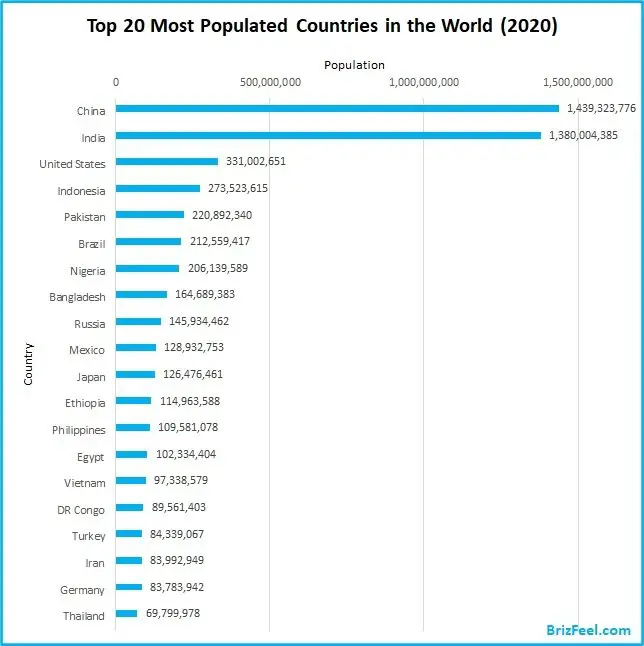Do you know which is the most populated country in the world?
What is the population share across the 6 regions in the world?
Also, from these 20 high population countries…
Which country has the highest fertility rate?
Which country has the lowest density and which has the highest density?
Why are European countries’ populations declining?
What’s the population forecast be like in the next 30 years?
You will get all the answers in this article.
Top 20 Most Populated Countries in the World (1955 to 2050) + Forecast
Before that, let’s watch a video about the past, present, and future population of the world from 1955 to 2050.
The Top 20 Most Populated Countries in 1955
Here’s the ranking of the top 20 countries with the most population in 1955:
- China – 612.24 million
- India – 409.88 million
- USA – 171.69 million
- Russia – 111.35 million
- Japan – 89.02 million
- Indonesia – 77.27 million
- Germany – 71.54 million
- Brazil – 62.53 million
- UK – 51.064 million
- Italy – 48.34 million
- France – 43.41 million
- Bangladesh – 42.09 million
- Nigeria – 41.09 million
- Pakistan – 40.489 million
- Ukraine – 40.02 million
- Mexico – 32.35 million
- Spain – 29.05 million
- Vietnam – 28.15 million
- Poland – 27.27 million
- Turkey – 24.27 million
In 1955, out of the top 20 countries, 8 are from Asia, 8 are from Europe, 2 are from Latin America/Caribbean, 1 is from Africa, and 1 is from Northern America.
The Top 20 Most Populated Countries in 2020
Here’s the ranking of the top 20 countries with the most population in 2020:
- China – 1.44 billion
- India – 1.38 billion
- United States – 331 million
- Indonesia – 273.52 million
- Pakistan – 220.89 million
- Brazil – 212.56 million
- Nigeria – 206.14 million
- Bangladesh – 164.69 million
- Russia – 145.93 million
- Mexico – 128.93 million
- Japan – 126.48 million
- Ethiopia – 114.96 million
- Philippines – 109.58 million
- Egypt – 102.33 million
- Vietnam – 97.34 million
- DR Congo – 89.56 million
- Turkey – 84.34 million
- Iran – 83.99 million
- Germany – 83.78 million
- Thailand – 69.8 million

Region’s countries in the top 20 list:
- Asia – China, India, Indonesia, Pakistan, Bangladesh, Japan, Philippines, Vietnam, Turkey, Iran, and Thailand.
- Africa – Nigeria, Ethiopia, Egypt, and DR Congo.
- Europe – Russia and Germany.
- Latin America/Caribbean – Brazil and Mexico.
- Northern America – United States.
In 2020, out of the top 20 countries with the most population, 11 are from Asia, 4 are from Africa, 2 are from Europe, 2 are from Latin America/Caribbean, and 1 is from Northern America.
Compared to 1955, Asia countries up by 3 from 8, Africa up by 3 from 1, Latin America/Caribbean and Northern America remain at 2 and 1 respectively, and Europe drop by 6 from 8.

Asia remains the region with the highest population, including the top 2 most populated countries – China and India, as well as the highest number of countries in the top 20 list. The three new members on the list are Thailand, Iran, and the Philippines.
Africa region is catching up with the 3 new members in the top 20 list, which are Ethiopia, Egypt, and DR Congo. These 3 countries are notable with their high yearly increments in the country population.
Europe region is the worst performer in population growth, losing 6 countries in the top 20 rankings.
Here’s the world population share by each region:

China, the most populous country, is taking a large piece of population share of 18.5% from the total world population of 7.74 billion.
In other words, for every 5.4 people in the world, 1 is from China.
That’s mind-blowing.
India, the country with the second-highest population in the world, is not far behind, raking 17.7% of the world’s share of population and has a fertility rate of 2.24, which is higher than China at 1.69.
Will India take over China to become the most populous country in the world?
We will see.
By looking at the growth in India and the high fertility rate of 2.24, it is possible, just a matter of time.
The Top 20 Most Populated Countries in 2050 (Forecast)
Here’s the forecast of the top 20 countries with the most population at 2050 based on historical data and fertility rate:
- India – 1.64 billion
- China – 1.40 billion
- Nigeria – 401.32 million
- United States – 379.42 million
- Pakistan – 338.01 million
- Indonesia – 330.90 million
- Brazi – 228.98 million
- Ethiopia – 205.41 million
- DR Congo – 194.49 million
- Bangladesh – 192.57 million
- Egypt – 159.96 million
- Mexico – 155.15 million
- Philippines – 144.49 million
- Russia – 135.82 million
- Tanzania – 129.39 million
- Vietnam – 109.61 million
- Japan – 105.80 million
- Iran – 103.1 million
- Turkey – 97.14 million
- Kenya – 91.58 million
From the list, Asia occupied 10 of the spots, followed by Africa at 6, Latin America/Caribbean at 2, Northern America at 1, and Europe at 1.

Africa continues to be the region with high population growth, grabbing two more spots on the top 20 most populated countries list.
According to the forecast, India will be taking over China for the top spot in the country population in the world.
Fertility Rate of the Top 20 Most Populated Countries in 2020 (Comparison)

DR Congo has the highest fertility rate at 5.96, followed by Nigeria at 5.42, Ethiopia at 4.3, Pakistan at 3.55, and Egypt at 3.33.
Out of 5, the top 3 and fifth are from Africa, and one is from Asia.
With these numbers, Africa is going to take more shares of the world population in the future.
Japan has the lowest fertility rate among the 20 countries at 1.37, followed by Thailand at 1.53, Germany at 1.6, China at 1.67, Brazil at 1.7, the United States at 1.78, and Russia at 1.8.
Out of 7, 3 are from Asia, 2 are from Europe, 1 is from Latin America/Caribbean, and 1 is from Northern America.
Median Age of the Top 20 Most Populated Countries in 2020 (Comparison)

Again, DR Congo from Africa scores the youngest median age at only 17, followed by Nigeria at 18.1, Ethiopia at 19.5, Pakistan at 22.8, and Egypt at 24.6.
Out of 5, Africa took 4 spots and the remaining 1 is from Asia.
On the flip side, Japan has the oldest median age at 48.4, followed by Germany at 45.7, Thailand at 40.1, Russia at 39.6, China at 38.4, and the United States at 38.3.
Land Size & Density of the Top 20 Most Populated Countries in 2020 (Comparison)

For Russia, despite having the largest piece of land in the world, the low birth and fertility rate limit the population growth, resulting in the lowest density among all other countries.
On the other side, Bangladesh has the highest density at 1265 P/km2 due to the smallest land area in the top 20 countries.
Summary (Detailed Table)
Here’s the summarized data of the top 20 most populous countries in 2020:

7 Factors that Affect Country Population Growth
Many factors contribute to the country’s population count and growth rate.
And here are the 7 main factors that have significant impacts on the country population numbers:
- Death rate
- Infertile
- Low birth and fertility rate
- Economy
- Government effort
- Migrants
- Urban to rural ratio
1. Death Rate
Common death-causing diseases like heart disease and stroke, which contribute a large percentage of all deaths in certain countries.
And if the deaths exceed births, the population will decline drastically in the long term.
Also, serious world crises like the coronavirus pandemic impacted the death rate significantly across multiple countries.
As of 2 May 2020, the death toll has crossed 238,628, with the United States the highest at 62,406, followed by Spain at 25,100, Italy at 28,710, the United Kingdom at 28,131, France at 24,724, and Germany at 6,649.
Which further reduces the total population in the Europe and Northern America region.
2. Infertile
Some countries are facing a high percentage of infertile due to poorly performed abortions.
3. Low Birth and Fertility Rate
Europe is the region with the oldest population, due to declined birth and fertility rates, which cause a shift in the population’s age profile and rising the median age of the country’s population.
If the birth rate falls below the level needed to maintain a stable population, it could lead to rapid aging and shrinking populations.
4. Economy
A country’s economic strength is one of the important factors to support population growth.
Raising a child to adult needs money, and an adult needs to work to earn money for food, drink, and shelter to survive.
It’s a realistic world.
Based on the survey, the financial burden is one of the common reasons why parents choose to have fewer children.
The improving economy will have a positive impact on the country’s birth rate.
5. Government Effort
Government effort is another important factor in the country’s population growth.
For instance, Italy has the highest ratio of elderly to youth in the world due to the low fertility rate.
Hence, the Italian government has put in the effort to reverse the downward trend by offering financial incentives to parents who have children and increase immigration to minimize the drop in the workforce.
In Greece, the government is offering cash incentives of 2,000 euros ($2,235) per birth to fight against the dropped fertility rate.
In some Islamic countries, the government is providing incentives like education subsidies, tax relief, and cash rewards to parents who gave birth and have more children.
The government also actively runs campaigns and seminars to educate the parents on the importance of giving birth to the country’s growth.
6. Migrants
Migrants are part of the population equation.
People immigrating and emigrating from the country will cause the country’s population to fluctuate.
For some countries, migrants are important to support the economy and fill the labor gap.
Certainly, countries with better financial standing, living conditions and loose immigration laws tend to attract more migrants.
On the flip side, countries with poor employment rates and low average wages will cause citizens to emigrate from their countries at large scale.
7. Urban to Rural Ratio
On average, urban areas tend to have a lower fertility rate than rural areas, mostly due to financial issues and education.
For instance,
In our survey to the parents in both urban and rural areas, a majority of urban parents said they have used certain birth control and contraception methods, partly due to financial burden for raising a child, and partly due to time, as parents in the urban areas usually to have more demand in lifestyle, meaning they have lesser time to give birth and raise a child.
For rural areas, life is simpler and the living cost is lower, which promotes birth rate indirectly.
Besides, most of the parents in rural areas lack contraception knowledge, which causes a higher fertility rate from each family.
In some parts of the world, women in rural areas have no or minimal access to job opportunities, and the main job as a woman is to give birth and raise children.
Conclusion
The world population is on the growing trend from 1955 to 2020.

But it’s not the case for all the countries.
Some countries are growing rapidly in their populations, but some are facing a decline in their populations.
A country’s population is crucial to ensure healthy growths on workforce, economy,
Shrinking in population is a serious issue that has to be tackled to protect the country from vanishing in the future.
Read Next:

